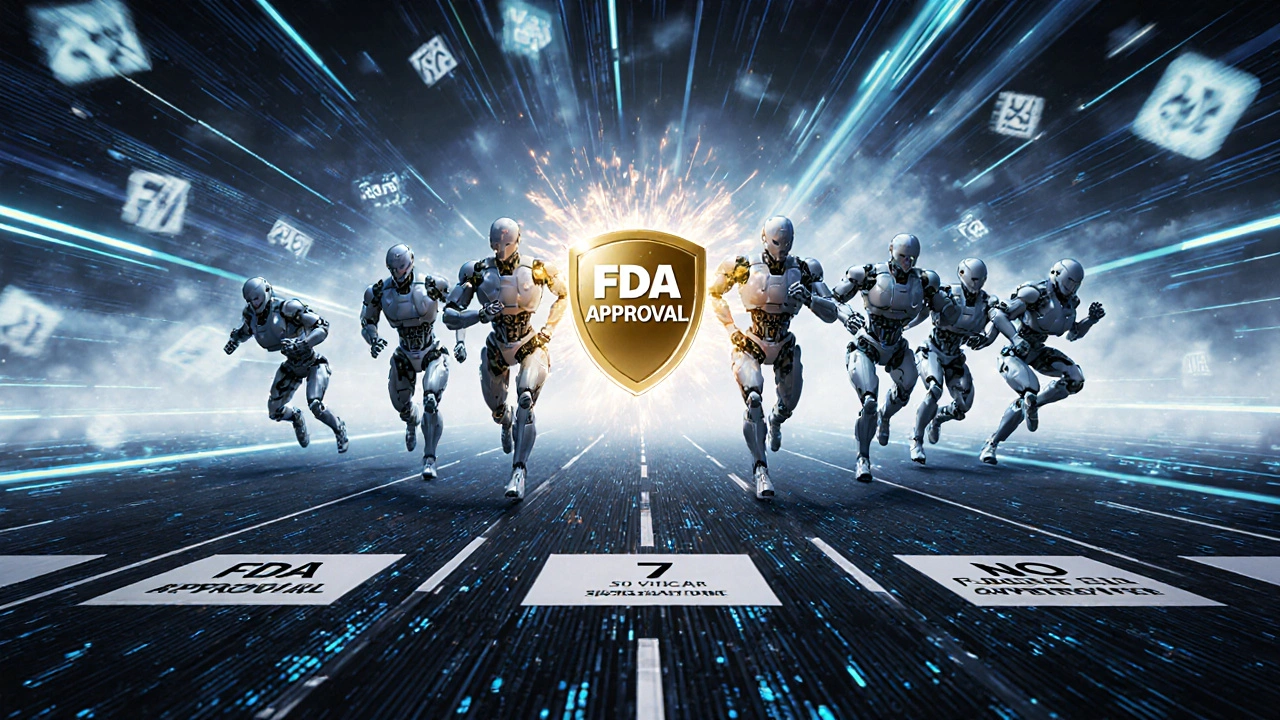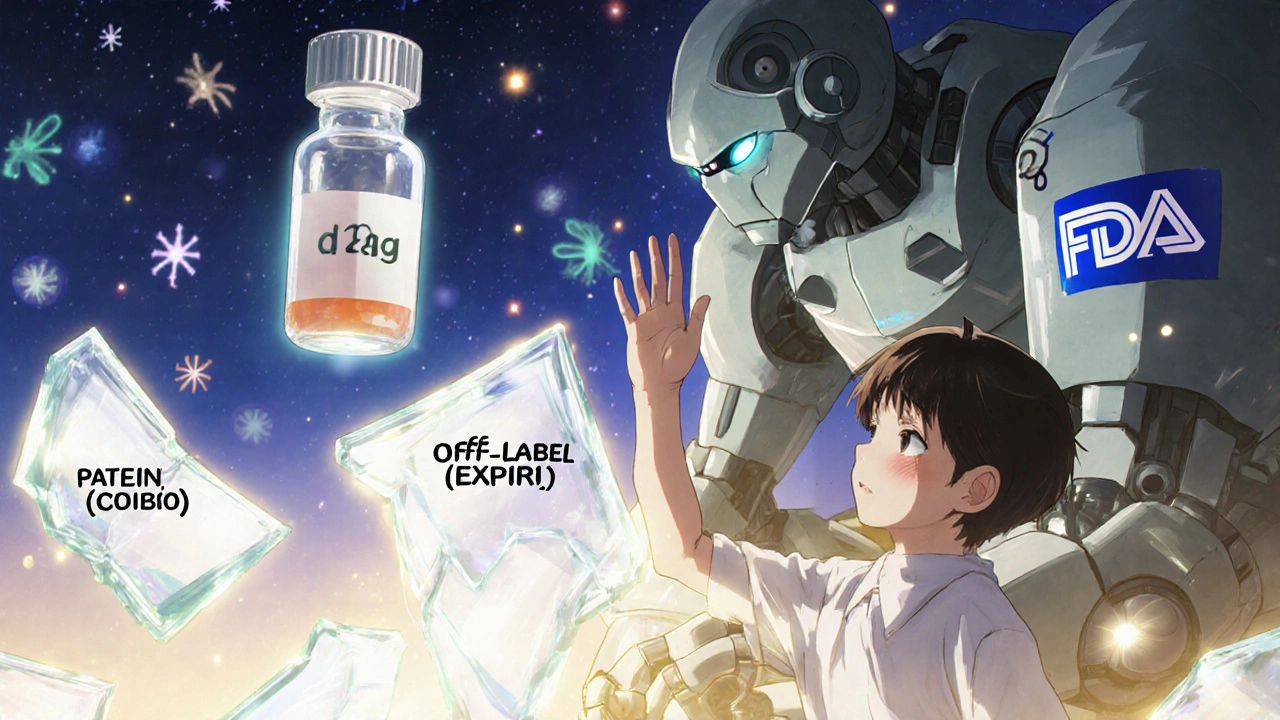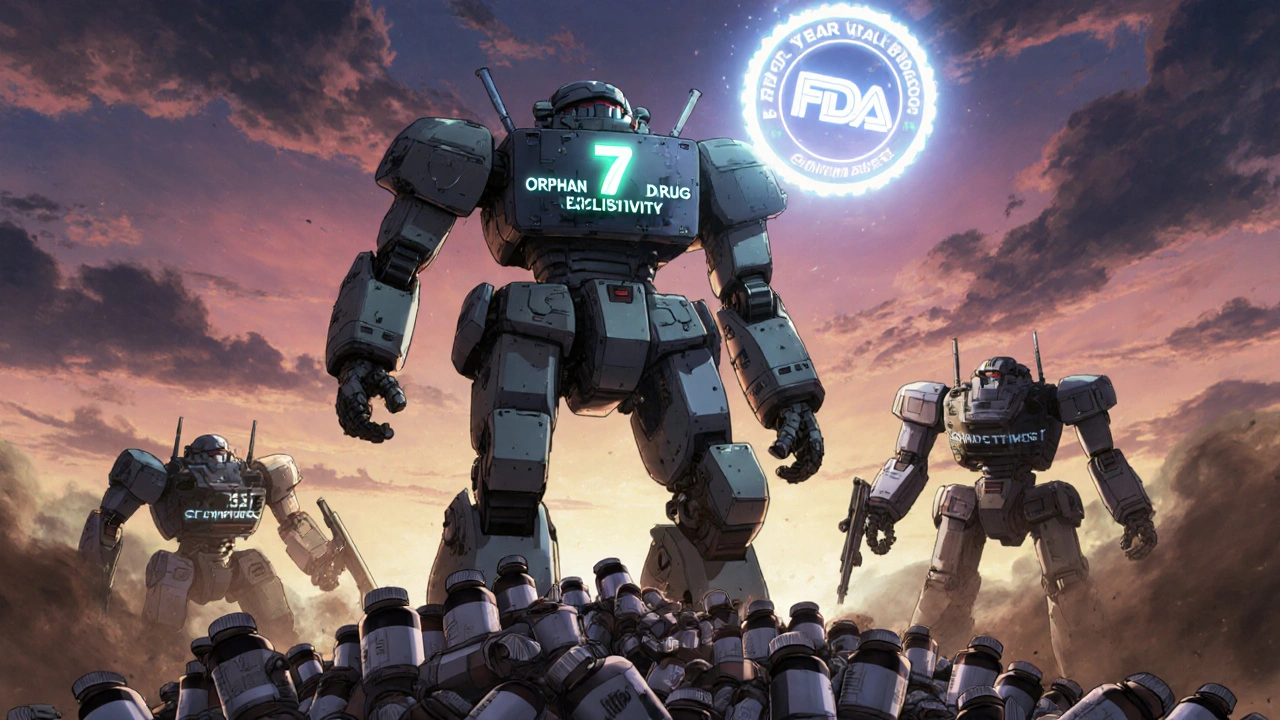Before 1983, fewer than 10 treatments existed for rare diseases in the U.S. Today, more than 1,000 are approved. The shift didn’t happen because drug companies suddenly cared more about small patient groups. It happened because of a law that changed the math: the Orphan Drug Act.
What Is Orphan Drug Exclusivity?
Orphan drug exclusivity is a seven-year period of market protection granted by the U.S. Food and Drug Administration (FDA) to a drug approved for a rare disease. It doesn’t mean the drug is patented. It means no other company can get approval for the same drug, for the same condition, unless they prove their version is clinically superior. The FDA defines a rare disease as one affecting fewer than 200,000 people in the U.S. That’s not a lot of patients. For a drug company, spending $150 million to develop a treatment for 8,000 people doesn’t make financial sense-unless there’s a guarantee they won’t face competition right after launch. That’s what orphan exclusivity does. It turns a risky, unprofitable project into a viable business. The clock starts ticking on the day the FDA approves the drug for marketing. Once that happens, other companies can’t submit applications for the same drug and same indication. Even if they develop their own version from scratch, the FDA will reject it unless they can show their drug is better-like significantly improving survival, reducing side effects, or working in patients who didn’t respond to the original.How It Works: The ‘Winner Takes All’ Race
Here’s the twist: multiple companies can apply for orphan designation for the same disease and the same drug. But only the first one to get FDA approval gets the exclusivity. It’s not about who started first. It’s about who finished first. Think of it like a race with a big prize at the finish line. Ten runners might line up with the same goal. But only the first one to cross gets the seven-year monopoly. The rest go home empty-handed-even if they spent just as much time and money. This system creates pressure. Companies rush to complete clinical trials, file applications, and get approvals. It’s why you see so many orphan drugs hitting the market in clusters-multiple drugs for the same rare disease approved within a few years of each other. The FDA has approved over 1,000 orphan drugs since 1983. But only 60 of those 503 drugs approved between 1983 and 2018 relied on orphan exclusivity as their main protection. For most, patents still did the heavy lifting. That’s because orphan exclusivity doesn’t protect the drug’s chemical structure. It only protects the drug for one specific use. If a drug treats two conditions-one rare, one common-the exclusivity only blocks competitors for the rare one. The common use? Open for generics.How It Compares to Other Countries
The U.S. gives seven years. The European Union gives ten. And in Europe, if a company studies the drug in children, they can get two extra years. The EU also has a loophole: if a drug ends up selling way more than expected, the exclusivity can be cut from ten years down to six. The U.S. doesn’t have that flexibility. Once you get the seven years, it’s locked in. That’s why some companies target the U.S. market first. It’s more predictable. No risk of the clock being shortened. But there’s a trade-off. The EU’s longer period means more time to recoup costs. The U.S. system is faster and more competitive. Companies know they have to move quickly. If they’re not first, they get nothing.
Why Companies Fight for It
In 2022, orphan drugs made up 24.3% of the global prescription drug market-$217 billion in sales. That’s up from 16.1% in 2018. Oncology drugs dominate this space, making up nearly half of all orphan approvals. But you’ll also see them in neurology, blood disorders, and metabolic diseases. For a small biotech firm, orphan exclusivity isn’t just helpful-it’s essential. One regulatory affairs manager told a professional forum that without it, they couldn’t justify spending $150 million on a drug for 8,000 patients. That’s not an exaggeration. The cost to develop a drug is high. The patient pool is tiny. Without exclusivity, no investor would touch it. But it’s not perfect. Some big pharmaceutical companies have used the system to extend protection for drugs that already made billions. Humira, for example, got orphan designations for several rare conditions-even though its main use was for common autoimmune diseases. Critics say that’s gaming the system. The FDA hasn’t stopped it.Limitations and Controversies
Orphan exclusivity doesn’t protect against every kind of competition. It doesn’t block generics for other uses of the same drug. It doesn’t stop doctors from prescribing the drug off-label. And it doesn’t stop companies from making slightly different versions-like new formulations or delivery methods. The biggest legal hurdle for competitors? Proving clinical superiority. The FDA requires a “substantial therapeutic improvement.” That’s a high bar. Since 1983, only three companies have successfully done it. Most try, but fail. So the original drug stays alone on the market for seven years. There’s also the issue of pricing. A 2022 survey by the National Organization for Rare Disorders found that 78% of patient groups believe orphan exclusivity is essential. But 42% worry about the high prices that result. Some orphan drugs cost over $500,000 per year. That’s because the company has no competition. They set the price. The FDA is now reviewing how to prevent abuse. In May 2023, they released draft guidance to clarify what counts as the “same drug.” This came after a case where a company got approval for a drug already approved for a similar condition-raising questions about whether the exclusivity was being stretched too far.
How to Get It: The Process
To get orphan exclusivity, a company must first apply for orphan designation. That happens early-usually during Phase 1 or early Phase 2 clinical trials. The application needs to show:- The disease affects fewer than 200,000 people in the U.S.
- There’s no existing treatment, or the new drug would be significantly better
- The drug has a plausible biological mechanism for treating the disease
What’s Next for Orphan Drug Exclusivity?
By 2027, nearly three out of every four new drugs approved by the FDA are expected to have orphan status. That’s up from just over half in 2018. The trend is clear: rare diseases are becoming the next big frontier in drug development. The EU is considering cutting its exclusivity period from ten to eight years for drugs that sell too well. The U.S. isn’t there yet. But pressure is growing. Some lawmakers want to add a requirement: companies must prove the drug addresses an unmet medical need-not just a small patient count. Still, 94% of biopharma companies say orphan exclusivity is critical to their strategy. Without it, many rare disease treatments would never exist. The system isn’t perfect. It’s expensive. It’s sometimes misused. But it works. It’s the reason why a child born with a disease that once meant a short life now has a treatment. That’s the real value.How long does orphan drug exclusivity last in the U.S.?
In the United States, orphan drug exclusivity lasts for seven years from the date the FDA approves the drug for marketing. This protection applies only to the specific drug and the specific rare disease indication it was approved for.
Can a generic drug be approved during the exclusivity period?
No, not for the same drug and same rare disease indication. The FDA will not approve a competing application unless the new drug can prove it’s clinically superior-meaning it offers a substantial therapeutic improvement, such as better effectiveness, fewer side effects, or use in patients who didn’t respond to the original. Only three such cases have succeeded since 1983.
Does orphan exclusivity replace patent protection?
No. Orphan exclusivity is separate from patents. Most drugs still rely on patents as their main protection. Orphan exclusivity only blocks competitors for the specific rare disease use. If a drug has both orphan and non-orphan uses, generics can enter the market for the non-orphan uses even while exclusivity is active.
Why do some companies get multiple orphan designations for the same drug?
Companies can apply for orphan designation for different uses of the same drug. Each approved indication gets its own seven-year exclusivity period. This practice, sometimes called “salami slicing,” allows a single drug to have multiple protected uses. For example, a drug approved for three rare diseases could have 21 years of total exclusivity across all indications.
What happens if a drug is already approved for a common disease and then gets an orphan designation?
It’s allowed. The Orphan Drug Act doesn’t require the drug to be new or unprofitable. A drug like Humira, which treats common autoimmune conditions, can still get orphan status for a rare use. Once approved for that rare use, it gets seven years of exclusivity for that indication-even if it’s already sold widely for other reasons. This has sparked debate about whether the system is being exploited.

Jeremy Hernandez
Let me get this straight - we’re giving drug companies a 7-year monopoly on life-saving meds for 8,000 people but acting shocked when the price hits $500K a year? This isn’t medicine, it’s legalized extortion. The FDA’s basically handing out golden tickets to the richest corporations while families go bankrupt just to keep their kids alive. And don’t even get me started on Humira getting orphan status for a rare use after making billions on the common one. This system is rigged.
Tarryne Rolle
There’s a deeper irony here - we’re celebrating this as a triumph of compassion when it’s really just capitalism repackaged as charity. The real miracle isn’t the drugs - it’s how we’ve convinced ourselves that profit motives and patient survival are compatible. We’ve built a system where human suffering becomes a spreadsheet line item, and then pat ourselves on the back for not letting it go completely to waste. We’re not saving lives - we’re monetizing desperation.
Kyle Swatt
Man I’ve been thinking about this all day and it hits different. These drugs? They’re not just chemicals in a vial - they’re the difference between a kid watching their first sunrise or not. But the system? It’s like a high-stakes poker game where the house always wins. Companies don’t build these drugs because they care - they build them because the math finally adds up. And yeah, that’s fucked. But what’s worse? Letting kids die because the ROI’s too low… or letting corporations turn grief into a billion-dollar industry? I don’t know. I just know we’re all complicit in the silence.
saurabh lamba
lol at the US thinking they invented compassion 😂
Kiran Mandavkar
How can anyone with a functioning brain still believe this system is ethical? The fact that the FDA approves orphan designations for drugs already making billions shows the complete collapse of regulatory integrity. This isn’t innovation - it’s regulatory arbitrage dressed up as humanitarianism. Anyone defending this is either complicit or profoundly ignorant.
Eric Healy
you guys are missing the point. without this law, we’d have maybe 10 orphan drugs still. now we got over 1000. yeah the prices are insane but what’s the alternative? let people die because the market ‘shouldn’t’ profit? capitalism isn’t perfect but it’s the only thing that gets shit done. also i think the FDA should just give out exclusivity based on actual unmet need not just patient count. but still - 1000 drugs? that’s a win.
Shannon Hale
OH MY GOD. I JUST REALIZED SOMETHING. THIS IS EXACTLY HOW PHARMA MAKES MONEY OFF TRAGEDY. THEY TARGET THE MOST VULNERABLE PEOPLE - CHILDREN WITH RARE DISEASES - AND THEN CHARGE ENOUGH TO BUY A SMALL COUNTRY. AND WE CALL IT ‘INNOVATION’? NO. THIS IS A SCAM. A GLORIFIED, FDA-APPROVED EXTORTION RING. AND THE WORST PART? WE’RE ALL TOO TIRED TO FIGHT IT. I’M CRYING RIGHT NOW. I’M SO ANGRY. I’M SO SAD. I’M SO ASHAMED.
Holli Yancey
I think we need to remember why this law was created - because no one was doing anything for these patients. Even if the system is flawed now, it gave hope where there was none. Maybe the answer isn’t to scrap it, but to add safeguards - price caps, clawbacks if profits explode, or requiring companies to offer access programs. It’s messy. It’s imperfect. But the alternative? Back to the dark ages. I just wish we could hold both the pain and the progress at the same time.